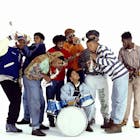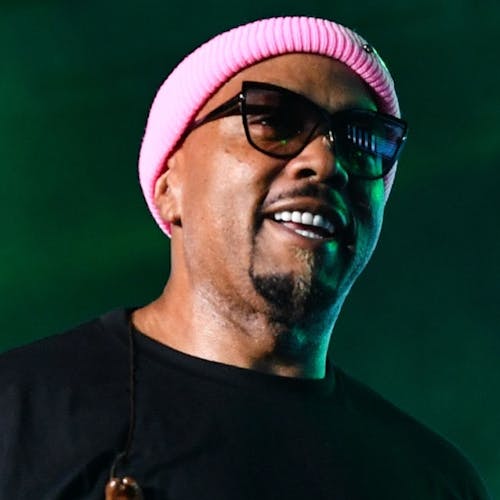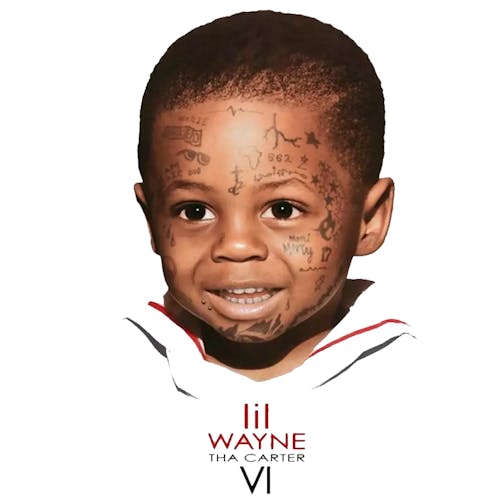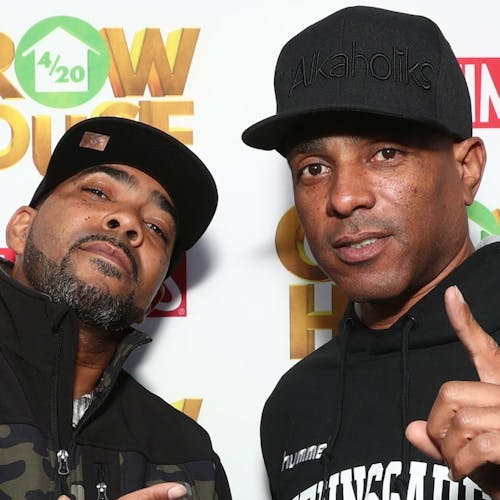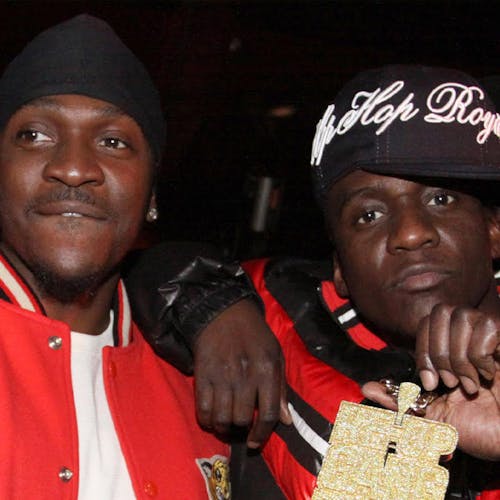
Kool DJ Red Alert has 4 decades on the radio under his belt. Come check Red out live at this year's Rock The Bells Cruise.
Hip-Hop continues to evolve its 51st year, and relevancy in the genre is no longer tied to ageism. But Kool DJ Red Alert continues to exemplify how at age 66 he’s helped break down that barrier, just like the culture has in the mainstream and beyond.
The revered DJ trinity during Hip-Hop’s formative years was Grandmaster Flash, Afrika Bambaataa and the culture’s ostensible founding father, Kool Herc. When rap records gained groundswell on FM radio in Hip-Hop’s birthplace, New York City, during the following decade, the DJ trinity on the airwaves was Mr. Magic, Chuck Chillout, and Kool DJ Red Alert.
Red Alert is celebrating 40 years as a radio DJ and over 45 years spinning at parties. He currently presides over a weekly time slot on WBLS 107.5 FM. His other moniker, “Uncle Red," given to him by his peers in the Hip-Hop community, signifies his earned respect as a trailblazer on WBLS’s former competing station WRKS Kiss 98.7FM, the gold standard for urban contemporary radio in the 1980s.
Red Alert was immortalized on Rob Base and DJ EZ Rock’s 1987 enduring classic, "It Takes Two," which urged listeners to “listen to Red Alert," and in addition to his 100-plus music video appearances spanning four decades, he was anointed as a Global Music Ambassador by the United Nations.
Born as Fred Crute in Antigua and raised in Harlem, Kool DJ Red Alert became known for his calm demeanor, smooth drawl, permanent three-quarter smile and ever-present black army fatigue hat, which played into his “Kool” moniker. The nickname “Red” sprang from his naturally red hair and light complexion, while “Alert” came from his time as a standout high school basketball recruit, when he was a vaunted defender. Rooted in Hip-Hop street organization Universal Zulu Nation’s “peace, love and having hun” inclusivity mantra, Red creates his DJ sets consisting of R&B, pop, alternative rock, dancehall for his Caribbean heritage, dance, house, and more. That bridged the gap across various ethnic demographics to speak to the genre’s diversity.
On the radio and on records, Red Alert’s signature drop is a falsetto “Yeaaaaaahhh!” He’s heard on such cuts as Jungle Brothers’ “Jimbrowski” and “Beyond This World,” Boogie Down Productions’ “The Bridge Is Over” and A Tribe Called Quest’s “Pubic Enemy.” Red gained his love for radio by listening to WBLS personalities and DJs and urban contemporary during his youth. He also loved The Rolling Stones, The Beatles, The Beach Boys and Motown Records artists.
“In the early days, growing up before FM, there was an AM station, WABC,” Red Alert says. “It had Chuck Leonard, “Cousin Brucie,” Vick Morrow and Dan Ingram. Down the end of the dial, you had WWRL—Hal Jackson, Jerry Bledsoe, Hank Spann—and they were playing nothing but soul music. WABC was more like Top 40.”
Red became New York Hip-Hop’s most prominent nightclub DJ and radio jock thanks to his Friday and Saturday night mixshow, Red Alert Goes Berserk. He was mentored in radio by a longtime friend, former KISS and WBLS host Fred “Bugsy” Buggs. That program helped break acts such as underground Hip-Hop pioneers Ultramagnetic MCs; Native Tongues original crew members De La Soul, A Tribe Called Quest, Jungle Brothers (featuring Red’s nephew Mike G.) and their late music mogul Chris Lighty (who passed away in 2012), Queen Latifah, Black Sheep, Monie Love, and Chi-Ali; and KRS-One’s Boogie Down Productions, with whom Red joined forces—both on record and on the air—during the legendary “Bridges Wars” against the Juice Crew.
DROP YOUR EMAIL
TO STAY IN THE KNOW
“In 1986, I had a job in Brooklyn as a janitor for a children’s day-care center, and as I was mopping the floors there, Red Alert played (BDP’s debut single) ‘South Bronx’ on the radio,” KRS-One recalled. “The funny thing was, it was a small radio, almost like a transistor radio, and very low volume. I could barely hear it, but I knew that it was my song that was playing. I was excited, but my excitement was quickly controlled. I felt that it would be embarrassing for me to declare--with a mop in my hand—‘that’s me!’ So, I celebrated silently, inwardly.”
Red not only had a Midas touch to create a buzz on records he played, but maintained his integrity by spinning tunes from various genres he liked and created popular demand instead simply following it.
Former Def Jam exec and Rush Management founder Russell Simmons used to bring his acts’ records to Mr. Magic and Red Alert, who was on the air at New York’s’ former top urban station and the pioneering WRKS before Chuck Chillout started in 1984. The first record that Red Alert played from Simmons was Run-DMC’s “Sucker MCs,” the B-side of the Rock and Roll Hall of Famers’ 12-inch single “It’s Like That.”
Red Alert also helped break Def Jam’s longtime flagship artist LL COOL J onto the airwaves. “At one time there was only Mr. Magic and Red Alert, that was it,” Simmons said. “All the records we made, we brought to [Red Alert]. He was the biggest thing in town. Once he was on the air, he was bigger than Magic. I respected his ears. If I gave Red Alert a record and he didn’t want to play it, I had to second-guess that record… Red Alert had golden ears.”
Another example is legendary rap group Brand Nubian’s frontman Grand Puba, who had his original group Masters of Ceremony’s earliest singles released in 1985. Their debut single, “Crime,” was on M-Low Records, and the two follow-up singles “Cracked Out” and “Sexy,” which came out the following year on Red Alert’s cousin and Universal Zulu Nation DJ Jazzy Jay’s imprint Strong City Records.
“The record that everybody liked, ‘Sexy,’ he wasn’t playing it, but (Red) loved ‘Cracked Out’ and played that to death,” Grand Puba claims. “He really had to like your record in order for him to play it, and I was impressed with that.”
The Rap Radio Wars
Barry Mayo, former program director of leading Chicago station WGCI, said he was hired by “failing” New York City urban station WXLO radio station’s general manager Lee Simonson to be its assistant PD in May 1981. Mayo said WXLO was distant third place in the Arbitron ratings behind its competitors WKTU and WBLS, which frequently swapped the top spots. RKO General was the corporation that owned WXLO and had changed its format from soft rock to urban contemporary based on the success of WKTU. Simonson put Mayo in charge of the music and hiring WXLO’s DJs.
“It came down that he needed someone who knew the music, knew the marketplace, so he hired me with the promise that within one year I would become the program director,” Mayo says. “When Kiss came on the air, we were modeling ourselves more after KTU—and this was a corporate dictate—than BLS, which had an overwhelmingly Black audience with some white listeners. KTU’s audience was one third Black, one-third Latino and about a third white. For straight-up marketing and advertising purposes, the general manager did not want Kiss to be pure Black because, frankly, there was so much racism in the advertising community. Even though BLS had superior ratings, they got outbilled by stations like KTU, which were looked at as more attractive to advertisers.”
But WXLO’s format change didn’t have immediate success after it became FM 99, with its meager “From The Streets” slogan, and research indicated that its call letters wouldn’t resonate with the city’s urban music audience.
WBLS was a market leader with the powerful competing rap show Rap Attack, hosted by Mr. Magic. WBLS program director Frankie Crocker was a music industry magnate who broke records targeting a sophisticated adult demographic with eclectic fare such as The Commodores, Bob Marley, The Bee Gees and Dinah Washington. Crocker hired Mr. Magic from WBHI in July 1982, and put Rap Attack on weekend nights from 7 to 11 p.m. Magic eventually added Tyrone “Fly Ty” Williams and young DJ Marley Marl, who became one of rap’s greatest producers and de facto leader of the Queensbridge projects-based Juice Crew in his native Queens. He was also in-house producer and co-founder of Cold Chillin’ Records with Williams. That imprint boasted rap legends MC Shan, Kool G Rap, Big Daddy Kane, Biz Markie, Roxanne Shanté, Masta Ace and Craig G.
The self-nicknamed “Chief Rocker” Crocker became Mayo’s idol-turned-sworn rival at R&B star Millie Jackson’s concert at The Beacon Theater in 1981. He approached Crocker backstage, then Crocker arrogantly blew cigarette smoke in Mayo’s face and laughed in response to Mayo’s request to have lunch with him and discuss the New York radio market. That set off the radio wars between Kiss and WBLS. Mayo went to nightclubs with Profile Records’ head of radio production, Manny Bella, and often recruited top club DJs to spin on the air. At The Funhouse he met John “Jellybean” Benitez, who would remix records by Madonna, Whitney Houston, Michael Jackson, Talking Heads and The Pointer Sisters, and was heavily influential on breaking dance records and the genre Latin freestyle. At the Roxy, he met DJs Chuck Chillout, Afrika Bambaataa, Jazzy Jay, and Red Alert and had them all spin on Kiss FM.
Large crowds were awestruck by Jazzy Jay’s and Chuck Chillout’s “superior technical skill in terms of scratching and mixing,” according to Mayo. But Mayo insists Red was the true standout because he had a “superior response on the dance floor” and played hits that people knew, despite not being as flashy and scratched less than the other two DJs. Red Alert was officially hired in October 1983, reporting to Mayo’s assistant, Tony Quartarone. He was put in charge of the Kiss DJs after Mayo was promoted to PD, adding such turntable whisperers as the Latin Rascals and Shep Pettibone for their mastermixes.
Red’s acumen for playing hit songs in his sets with rap aligned with the Kiss testing R&B, dance and pop records such as “Let’s Dance” by David Bowie, Toni Basil’s “Mickey,” and Blondie’s seminal rap-rock classic “Rapture” to white and Latino audiences rather than just the Black community. That helped propel it from an upstart station to dominant force, surpassing BLS in the nation’s top radio market. Native Tongue Crew, Chris Lighty Rise Under Red Alert Red Alert was known for playing hit singles, but he also played 30-second promo record snippets with stellar beats from rap groups who rapped on them to market themselves on his mixshow. Those records helped many of those acts land album record deals.
De La Soul’s DJ Maseo was already signed to Tommy Boy on a singles-only deal in 1987 when Red first played their debut track “Plug Tunin.” The record exploded in 1988, and Tommy Boy offered the trio an album deal, and that song became the lead single of De La’s groundbreaking 1989 debut LP, 3 Feet High and Rising.
Then, at a Boston concert when they were on the same lineup that year, Jungle Brothers formed the Native Tongues with De La Soul and A Tribe Called Quest. Red’s eponymous company Red Alert Productions originally had A Tribe Called Quest, De La Soul part of his clientele, too.
“There was already an admiration for the Jungle Brothers prior to us getting in the business, and when we met, it was almost like a match made in heaven,” Maseo said. “At that time, I had no clue that Mike G was Red’s nephew. … I would go up to Red’s house a lot. I’m going up there not knowing this is Red Alert’s house. This one time, me and Mike are just working on some music, and this person walks into the room with his head poked around the side of the door. I’m like ‘Yo, that’s Red Alert!’ It made sense because there were records and sneakers everywhere.”
Red Alert initially took the Jungle Brothers under his wing when they were signed to Warlock Records and released their first album Straight Out the Jungle in 1988. The group’s biggest achievement with Red was the critically acclaimed second album and Hindu scripture-inspired title Done By The Forces Of Nature in 1989.
“It started out as a management, production company,” Mike G said. “R.I.P. to my man Funkenklein, who maybe partnered up with Red along with his attorney Ron Skoler. He had us, Red was involved with a lot of breaking records, and we were his first to manage. Then he did the compilation album, so that was the production he was doing as well as helping produce our first and second albums. I think midway as we left Warlock, Idlers (record labels), got into Warner Brothers, that’s when the business started to take its toll and he was making strides on radio. As a personality DJing all over the place and doing radio, then trying to manage us, I think just became too much and it was good that Chris Lighty stepped in.” Red Alert explained that he took Lighty under his wing after he met him at one of Hip Hop’s most storied havens Union Square with several of Chris’s crew The Violators in 1986. Red said Lighty was “arrogant and cocky, but had a good head on his shoulders.”
He gave Lighty his start in the music business — from carrying Red’s record-filled milk crates at clubs ,to putting him as a roadie on BDP’s 1987 U.S. tour, to promote their groundbreaking debut LP Criminal Minded.
“Chris is a good friend. We didn’t always agree, but the respect between us remained strong right up to his passing,” KRS-One remembered. “I find myself missing his voice, and his sincere advocacy for Hip Hop."
The Jungle Brothers were initially road managed by Lighty, and helped manage most of the Native Tongue groups until he left Red Alert’s company to work at the Simmons-helmed Rush Management in 1992. De La Soul and A Tribe Called Quest eventually followed Lighty to the Rush Management roster as they were signed to Tommy Boy and Jive, respectively. Mike G explained each group’s record label had different ideas for their signee’s career direction. The labels’ business dealings led to dissensions that eventually broke up the Native Tongue’s core in 1993 until the collective reunited three years later.
That breakup caused Red Alert to focus on radio moving forward, but Jungle Brothers stayed under Red’s management. After leaving Rush, Lighty became the founder of the Violator brand’s management and record labels with Mona Scott. He was 50 Cent’s former manager when the gangsta rap impresario released his nine-times platinum debut album, Get Rich Or Die Tryin’ in February 2003. Red Alert’s Hot 97 show inspired 1990s NYC rap’s biggest hits. Red helped give many esteemed DJs their starts on the airwaves by filling in for him at Kiss. That includes Jungle Brothers’ Sammy B, DJ Enuff, and leading Hip-Hop station Hot 97’s most storied personality, Funk Flex.
When Red attended or performed at music industry conventions such as New York’s New Music Seminar or Atlanta’s Jack The Rapper, or was spinning in nightclubs such as The Latin Quarters, Union Square, and The Roxy, or concerts during his 9 p.m. to midnight timeslot on Fridays and Saturdays.
“Magic and Marley were a great air personality and super producer, and that is incredible. Red Alert was a radio guy with the personality who was very big in the clubs,” said Funk Flex, who also did fill-ins for Chuck Chillout when he moved over to ‘BLS in 1989. “(Magic and Marley) both complemented each other, but Red Alert’s extension might have been a little bit more important because he extended it to the clubs when Magic and Marley weren’t in the clubs. (Red Alert) was bringing it to real life, in real form. That became the thing that (DJs) Clark Kent followed, that Kid Capri, that I followed.”
Funk Flex further explained that’s what Hip Hop’s two highly sought-after beatmakers in Gang Starr’s DJ Premier and Pete Rock followed Marley Marl’s producer-on-the-radio blueprint with their mix shows Thunderstorm and In Control with Marley on ‘BLS, respectively, in the early-to-mid-1990s. After Funk Flex moved over to Hot 97 in December 1992, shortly before it changed its rhythmic format as a dance music station to urban contemporary the next year, Kiss FM was bought by Emmis in 1994. Red left Kiss for Hot 97, and spun new records for the weekday afternoon drive time slot from 5 p.m. to 6 p.m.
Red also was influential in his weekday Old School At Noon mastermix, which played an array of 1970s disco and R&B with 1980s rap and pop classics. He believes many beatmakers and producers including Bad Boy Records, JAY-Z’s Rocafella Records, Boot Camp Clik’s Duck Down label, Trackmasters who frequently tuned into his show for ideas to create their most memorable hits. That includes, but not limited to Kool and the Gang’s “Hollywood Swingin” sampled for Mase’s 1997 single “Feels So Good,” and Bernard Wright’s 1985 track “Who Do For Love” for LL COOL J'S “Loungin” remix featuring Total in 1996.
“Bad Boy made it so obvious from what they were hearing,” Red Alert said. “What I was doing at the time, I wasn’t just always all Hip-Hop. I used to play a diversity of music. So when I played a diversity of music that was hip to the audience, that’s where everybody was embracing it.”
